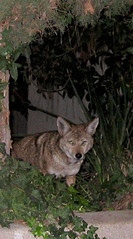A number of factors, including people leaving out food for animals, and the presence of unenclosed refuse containers encourage coyotes to interact with humans.
Coyotes are wild animals. Do not encourage or approach them. They are smart, fast, and they will take what they can get.
Cats should be maintained indoors at all times. Dogs must be kept under direct supervision and restrained by a substantial chain or leash not exceeding 6 feet in length while being walked in any public area.
The Department of Animal Services suggests the following guidelines to assist residents in co-existing with this wildlife:
Read more...
- Do not leave small children and pets (even if caged) unattended outdoors.
- Should you have to maintain your pet outdoors and you have the room to do so, consider the placement of an enclosed dog or cat run adequate in size to allow your pet exercise. The run should contain a 6 sided shelter and potable water and have some shade to protect your pet from direct sunlight.
- Do not encourage, entice, app roach or feed mammalian wildlife such as coyotes, which is a violation of the law. (L.A.M.C. 53.06.5)Please remove your pet’s food dish or bowl when your pet has inished eating and do not leave any unattended foods outdoors.
- Pick up all fallen fruit & berries from your yard and if possible, do not leave ripened fruit on branches. Trim ground level shrubbery and low hanging branches. Enclose or remove wood piles.
- Enclose vegetable gardens with sturdy welded wire mesh or greenhouse.
- Clear dense vegetation to reduce wildlife hiding places.
- Secure crawls spaces such as access ways under the house, decks, and porches by screening of with high gauge welded wire mesh where possible. Do not use chicken wire as most wildlife can chew right through it.
- Block access under storage sheds and containers.
- Clean all grills or barbecues after use.
- Secure or store trash containers in enclosed structures or securely strap down the lids, do not place refuse containers out until the day of service. Spray ammonia occasionally in the trash to cut down on food odors.
- Canned goods, water bottles, soda cans, soaps, cosmetics, toiletries, and trash, unwashed items that were used for preparing or eating meals can become food. Coyotes are opportunistic predators and eat fruit, vegetables, and refuse in addition to their usual prey.
- Report abandoned or severely neglected unkempt property to the Department of Building and Safety and overgrown brush to the Fire Department as wildlife may often take up living at such locations.
- Keep your property well lit at night and use motion lights when possible to help alert you to activity outdoors.
- Placing an electronic motion activated device such as a motion alarm with strobe or motion activated sprinkler may help to discourage wildlife from your property. A radio plugged in to a motion activated outlet may scare away wildlife outside (Use caution for outdoor electronics near water sources and avoid setting out where
- they may be rained on).
- Make sure that your fence is secure. Check for gaps and openings that even a cat can it through. Fence heights should be increased to 6 feet when possible and have an angled addition at the top extending outward for and additional 16 to 24 inches at 45 degrees. Coyotes have been known to scale chain-link so consider options to block climbing. Wrought iron bars should be no further apart than 4” inches in width to avoid wildlife squeezing between or even your pet from exiting. You might also consider wrought-iron mesh to cover half way up the fence height as well. Coyotes may walk on top of brick or cinder block walls so consider obstructing the top of the wall with lattice, lower pots, etc. (A variance may be required for fences over 6 feet in height.)
- Do not turn and run. Running may be the trigger for the coyote to chase you and coyotes can sprint at up to 40 mph.
- Teach children never to approach coyotes just as you would tell them about stray dogs.
- Make yourself appear larger by raising your arms and waiving them. If you have a jacket or belt with you, wave it around over your head and yell in a loud low tone at the coyote.
- Stomp your foot and clap your hands to scare them.

